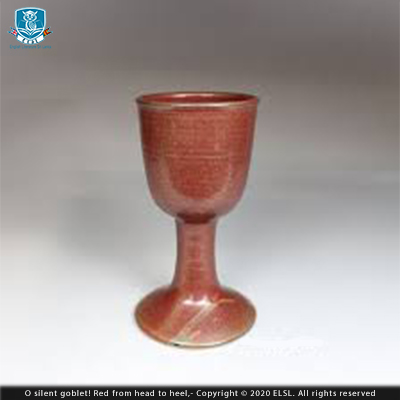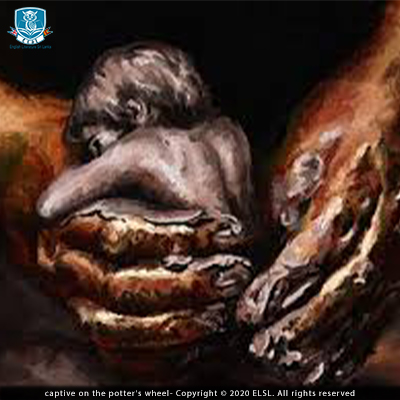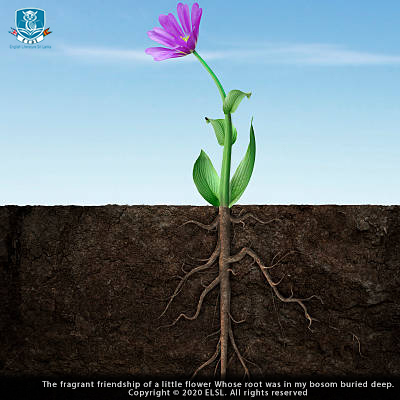The Earthen Goblet - Harinidranath Chattopadhyay
O silent goblet! Red from head to heel, [a]
How did you feel [a]
When you were being twirled [b]
Upon the potter’s wheel [a]
Before the potter gave you to the world! [b]
‘I felt a conscious impulse in my clay [a]
To break away [a]
From the great potter’s hand [b]
That burned so warm, [c]
I felt a vast [d]
Feeling of sorrow to be cast [d]
Into my present form. [c]
‘Before that fatal hour [a]
That saw me captive on the potter’s wheel [b]
And cast into his crimson goblet sleep, [c]
I used to feel [b]
The fragrant friendship of a little flower [a]
Whose root was in my bosom buried deep.’ [c]
‘The potter has drawn out the living breath of me [a]
And given me a form which is death of me, [a]
My past unshapely natural stage was best [b]
With just one flower flaming through my breast.’ [b]
For those who study Harindranath Chattopadyay’s “The Earthen Goblet” for a wider understanding (non G.C.E O/L readers), it is recommended to study his educational background and social influence, as well as his research interests. The poem connotes a secondary meaning where Chattopadyay attempts to validate Christian, and Sufi doctrines where God is regarded as a potter, and man as clay which is cast by his hands.
“But now, O LORD, You are our Father; we are the clay, and You are the potter; we are all the work of Your hand.” – Isaiah 64:8
“O house of Israel, declares the LORD, can I not treat you as this potter treats his clay? Just like clay in the potter’s hand, so are you in My hand, O house of Israel.” – Jeremiah 18:6
Further reading – Muddle of the Middle East, Volume 1, By Nikshoy C. Chatterji, Harindranath Chattopadyay – Biography
About the poet
Harindranath Chattopadhyay
Born on 02 Apr 1898 in the Deccan, India, Harindranath Chattopadhyay began to write verse as a child and also enjoyed acting due to the constant encouragement he had from his family. After his marriage to Kamaladevi, a Madrasi widow in 1919, Chattopadhyay moves to England, and later enters the Fitzwilliam Hall of the University of Cambridge to research on ‘William Blake and the Sufis’. Harindranath Chattopadhyay belongs to the “Navya” movement of Indian poetry, which is the equivalent of modernism in European literature.

Harindranath Chatoopadhyay

O silent goblet! Red from head to heel,

captive on the potter’s wheel

The fragrant friendship of a little flower
Structure
The overall poem can be regarded as a free-verse due to the lack of uniformity in its structure.
However, Harindranath Chattopadhyay uses the structure of the poem to add emphasis to the concept of nature versus nurture he attempts to elaborate in the poem. The first three stanzas are irregular in their rhyming schemes whereas the last is not. The shift from a heterometric stanza with irregular rhymes to an isometric stanza with a regular rhyming scheme at the final stanza indicates how nature dissipates with the enforcement of artificiality.
The syllabic beats in the first three stanzas are irregular and then becomes regular in the final stanza where each line (except the concluding line which has ten syllables) contains eleven syllables. The shift of the rhythm of the poem indicates the clash between nature and man as well as the concept of nature versus nurture.
The Topic
The Earthen Goblet
- Earthen means “made of baked or fired clay.”
- Goblet is a drinking glass with a foot and a stem, similar in shape to a chalice.
- The natural ingredient and the artificiality associated with the “goblet” figuratively indicates the clash between industrial/consumerist necessities of man and nature.
- The goblet is an extended metaphor in the poem, which stands for the concept of transformation.
Stanza 1
Line 1
O silent goblet! Red from head to heel,
- “O” is an interjection used to express the sudden strong emotion of the narrator when he first sees the goblet.
- Later in the stanza, the narrator prioritizes the physical pain underwent by the goblet – in the process of building up its current form. Therefore, the reader can understand that the exclamatory expression of the narrator indicates his concern towards the painful transformation process.
- The silence of the goblet figuratively indicates its dissatisfaction. It does not want to communicate with the rest of the world as it assumes that it is ravaged against its will.
- The redness of the goblet can be seen as a visual representation of the pain it had to undergo during its transformation.
- “head to heal” refers to the entire structure of the goblet. It functions in the poem as a personification as the narrator assumes the goblet to be alive.
Stanza 1
Line 2-5
How did you feel
When you were being twirled
Upon the potter’s wheel
Before the potter gave you to the world!
- The set of four lines function in the stanza as a single sentence that summarizes the primary question of the poem, the feelings of the goblet towards its change.
- The extended length of the line further functions as an elaborated indication of the extended duration of suffering the goblet had to undergo.
- The narrator directly addresses the goblet. When a personified object is directly addressed, we call it an apostrophe.
- The grammatical tense and the voice of the sentence switch from past tense – active to past progressive – passive, then back to past tense – active again.
- The past progressive tense in the phrase “were being twirled” shifts the focus from the action itself to the duration of the action [twirl]. It figuratively indicates the extended duration of time the goblet had to undergo excruciating physical pain.
- “when”, “were”, “twirled” are alliterations that add emphasis to the suffering of the goblet
- “were being twirled” is a phrase in the passive voice. With the change of voice, the narrator avoids indicating the one who is directly responsible for the suffering caused.
- The narrator suggests that the lump of clay is “twirled” on the potter’s wheel, yet avoids mentioning that it is the potter who is responsible for the applied pain.
- In the final line, the grammatical voice immediately changes to active, and the subject “potter” is mentioned, when a seemingly positive action is performed by him.
- The tone of the narrator suggests that he conforms to the perspective of the potter, and assumes that giving the goblet to the world is a positive action.
- It seems that the transformation of the goblet from its natural state rather benefits the “world” than the goblet itself. It figuratively indicates that sometimes transformation, from natural to artificial, uncivilized to civilized, nature to nurture rather serves for a collective purpose than providing a personal benefit to an individual. To understand the concept of the poet, think about the purpose behind a child attending school, which is a similar process of transformation to that of the goblet. Parallelly to the social advancement of the child who transforms from his rawness to a law-abiding citizen, the “world” is benefitted from having a conformist who will not strive to see a change.
- Both “you” and “potter” are repeated as they are the primary characters in the poem.
- The stanza which started with an interjection ends with an interjection.
Stanza one overall analysis.
- Even though there are end rhymes in the stanza and the rhyming scheme is AABAB, they are disarranged and lack any sort of a consistent sequence.
- The dominant grammatical tense is past, and it varies from simple to progressive and from active to passive, in order to connote layers of figurative senses.
- The overall tone of the stanza is conversational as the narrator expects to start a conversation with the personified goblet.
- Harsh consonant sounds dominate the overall tone of the poem indicating that it revolves around a crisis.
Stanza 2
Line 1
‘I felt a conscious impulse in my clay
- The poet uses an Amoebean as the voice of the previous narrator shifts to the voice of the goblet with the changing of the stanza.
- The goblet starts to speak, and it speaks of its feelings – turning it into a personified object.
- The consciousness of the goblet suggests that it actually comes to life (not a figment of the imagination of the poet), similar to an animated character in a cartoon. The conscious humanoid behaviour of the goblet can be regarded as an anthropomorphism.
- “Impulse” is an unreflective urge to act. It contributes to generate sympathy towards the goblet.
- “my” is a possessive pronoun that indicates the possessive nature of the goblet. It further indicates that what belongs to the speaker (goblet) has been forcibly transformed by the “potter”.
- Clay is a natural ingredient and functions as a metaphor for the rawness of nature and an individual which is meant to be transformed by a “potter”.
Stanza 2
Line 2
To break away
- The goblet’s need to “break away” indicates that it is captured against its will.
- The isolation of the phrase “to break away” adds emphasis to the non-acceptance of the goblet towards the change it is about to experience.
Stanza 2
Line 3
From the great potter’s hand
- The adjective “great” attributes reverence to the potter. The respect of the goblet towards the potter who causes him harm (according to the perspective of the goblet) is a controversial characteristic.
- Pottery, in the modern society, is not an idolized profession. However, to the goblet, the potter is his creator. Therefore, the reader can justify the idolization done by the goblet.
- Literally, the goblet wants to “break away” from the “hand” of the potter as the shape of the goblet is crafted by the hand. Yet, it is obvious that both hands are used for crafting pots, yet the speaker singularizes the body part [hand] in order to attribute a metaphorical sense. “Hand” therefore functions in the poem as a synecdoche, as well as an allusion that figuratively conveys both power and the concept of creation.
Stanza 2
Line 4
That burned so warm,
- The conjunction “That” indicates that the speaker continues to describe the characteristics of the “hand”.
- Even though heat is not generated from the “hand”, the goblet assumes otherwise. The biblical allusion to the concept of creation is thus extended.
- The intensifying adjective “so” adds emphasis to the excruciating physical pain underwent by the goblet.
Stanza 2
Line 5
I felt a vast
- “felt” is a repetition and it indicates the desperate necessity of the goblet to express his emotional agony to the outside world.
- The enjambment in the line extends to the end of the stanza – adding emphasis to the necessity of the goblet to rapidly express his reproach.
Stanza 2
Line 6
Feeling of sorrow to be cast
- “feelings” are continued to be expressed by the goblet. It literally emphasizes the fact that nature too can feel, regardless of the general prejudice of man who assumes it is not alive.
- The physical agony expressed in the first half of the stanza [burned], immediately shifts to an emotional agony [sorrow].
- “cast” is a complex term that has multiple figurative senses. But we will stick to the literal meaning “to make/ to mould by casting”
Stanza 2
Line 7
Into my present form.
- The utter emotional dissatisfaction of the goblet due to its word choice [cast] indicates that it considers its “present form” to be a discrimination.
- The word “present” exhibits the contrast between the past and present of the goblet on the one hand and the nostalgia associated with the goblet on the other hand.
Stanza 3
Line 1-3
‘Before that fatal hour
That saw me captive on the potter’s wheel
And cast into his crimson goblet sleep,
- The entire stanza is a single complex sentence and this is the subordinate clause that has been inverted to the beginning. (If confused, read the second half of the stanza first, and then read the first three lines)
- The inversion of the sentence adds emphasis to the main clause which appears later.
- The enjambment extends from the beginning to the end of the subordinate clause. The seemingly lengthy line which lacks punctuations – simulates the extended duration of physical suffering experienced by the goblet.
- The phrase “fatal hour” is personified as it [hour] saw the goblet “captive on the potter’s wheel”
- The word “captive” reveals that the goblet is captured against its will. It figuratively indicates the clash between man and the natural world.
Stanza 3
Line 4-6
I used to feel
The fragrant friendship of a little flower
Whose root was in my bosom buried deep.’
- This is the main clause that appears in the latter part of the sentence.
- Simple past tense “used to feel” suggests that the speaker [goblet] no longer feels what he used to feel. It further adds nostalgia to the clause.
- “feel”, “fragrant”, “friendship”, “flower” function as alliterations that add emphasis to the endearment the goblet felt.
- Friendship is an abstract sense. However, the fragrance associated with it functions as a synesthetic imagery.
- The singularity of the flower figuratively indicates a monogamic relationship, which later contrasts with the ability of the goblet to have many flowers without being bonded by roots.
- Even though a tree has many roots, the speaker uses singularization to attribute a metaphorical sense to the singular root.
Stanza 4
Line 1
‘The potter has drawn out the living breath of me
- The potter has been directly accused in the concluding stanza unlike in the rest of the poem.
- Even though the goblet claims that his life has been drained away, he still seems to be alive. Thus, the reader can understand “living breath” refers to the original state of the goblet where it had a direct connection to nature.
- The past tense used in the previous stanzas shifts to present perfect, indicating that the effects of the verbs [draw, give] apply to the present of the goblet.
- Unlike the poet who uses the passive voice to avoid accusing the “potter”, the goblet uses active voice directly making the “potter” responsible for altering his reality.
Stanza 4
Line 2
And given me a form which is death of me,
- The accusation of the goblet is extended with the coordinating conjunction “and”.
- The goblet compares its past, natural state with its current form – concluding the latter to be its “death”
Stanza 4
Line 3
My past unshapely natural state was best
- The contrast between past and present is extended as the wistful affection of the goblet for its past “natural state” is exaggerated in the penultimate line.
- “past unshapely natural” is an adjectival cluster used to modify the noun “state”. It indicates the release of the compressed emotional agony of the goblet.
- The superlative form used by the goblet [best] suggests that nature is irreplaceable.
Stanza 4
Line 4
With just one flower flaming through my breast.’
- The enjambment extends the idea of the previous line to this.
- The conclusion suggests that having a relationship with one “flower” is “best” while figuratively suggesting that the relationship is no longer monogamic.
- “flower flaming” is an alliteration that is similar to the previous one associated with the relationship of the goblet [feel, fragrant, friendship, flower].
Themes
Man versus nature
Nature vs nurture
Nature versus artificiality
Simplicity versus complexity
Past versus present
Transformation versus preservation
Freedom versus bondage
Life versus death
Copyright © 2020 ELSL. All rights reserved
Duplication, distribution and/or adaption of any part of the work without the written permission of ELSL is a punishable offence under the Intellectual Property Act, No. 36 of 2003. (Sri Lanka)
